Oceana
 Tuesday, October 6, 2009 at 01:55PM
Tuesday, October 6, 2009 at 01:55PM  The latest trend among upscale restaurants is the relocation. Bouley moved to a custom built chateau half-a-block away from the old Tribeca spot. Aureole moved from an old world townhouse to the bustle of the theater district. Dowdy San Domenico abandoned Central Park for Madison Park.
The latest trend among upscale restaurants is the relocation. Bouley moved to a custom built chateau half-a-block away from the old Tribeca spot. Aureole moved from an old world townhouse to the bustle of the theater district. Dowdy San Domenico abandoned Central Park for Madison Park.
And Oceana has moved from an east-side townhouse to the MacGraw-Hill building, convenient to Rockefeller Center and the Sixth Avenue office district, as well as the pre-theater crowd.
All four of these restaurants were expensive before and are expensive still, but only Bouley went upscale. The other three are more casual than they were before, less taxing on the wallet, and have informal front rooms for bar dining that they previously lacked. This is not to say that they were renovated on the cheap—indeed, major coin was dropped on all three. But these restaurants, in different ways, are trying to win a new fine-dining audience that their old places, for varying reasons, could no longer attract.
The food at Oceana has always been acclaimed. Under chefs Rick Moonen, Cornelius Gallagher, and now Ben Pollinger, the restaurant has always had three New York Times stars, most recently from Frank Bruni in an ill-timed mid-2008 review, published just after the move to Sixth Avenue was announced. The space, which resembled the interior of an ocean liner, seemed passé and a bit cramped. Our only meal at the old Oceana was on Valentine’s Day three years ago. It was, as special-occasion meals often are, a mixed bag.
The new Oceana is spacious, bright, and modern. There’s a big fish tank in front of a partly-open kitchen. The walls are decorated with unobtrusive nautical artwork. This is what the John Dory would have looked like, if Ken Friedman had taste. About half the tables have white tablecloths, and half don’t. I don’t recall seeing that design choice at any other restaurant, but it seemed to work here—perhaps because we were seated at one of the former.
There are changes, too, behind the scenes. The chef told us that he has six times the amount of kitchen space for double the number of dining-room seats. He gave us a tour of the facilities afterwards. We haven’t seen a kitchen this spacious since Per Se.
In the dining room, the prix fixe (formerly $78) has been jettisoned in favor of a carte. The menu sprawls a bit more than I would like, though not as badly as Marea. On average, you’ll spend less than the original prix fixe, though of course it is possible to spend a lot more. There’s the obligatory raw bar ($3–8 per piece, plateaux at $44 or $120); soups, salads and appetizers in two categories ($12–19), main courses in four categories ($28–48; plus fish by the pound that can go higher), and sides ($7–10).
The entrées are a choice of composed main courses, whole fish, “simply prepared” fish, or meats; and there’s a separate list of optional sauces. It is a bit daunting, and I always wonder if the kitchen can actually keep up the quality when trying to paint over such a large canvass. In any event, everything we had was excellent.

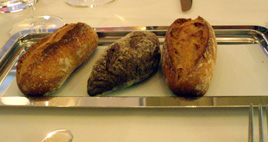
The amuse-bouche (above left) was a lobster bisque. The bread (above right) was apparently baked in house, though I found it a bit too tough.
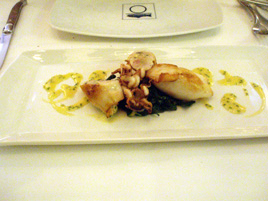
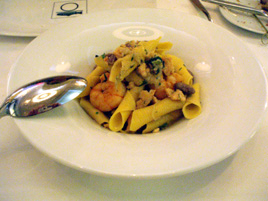
Seafood Sausage Stuffed Calamari ($17; above left) was one of the best appetizers we’ve had all year, with calamari serving as the “casing” for a rich, hearty sausage. We wondered whether Garganelli ($18; above right) was just a token pasta dish (the only one listed), but the combination of smoked shrimp, cranberry beans, and pancetta was wonderful.
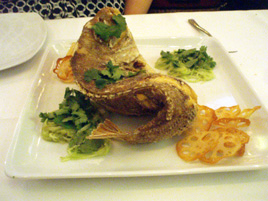

Curried Red Snapper ($72; for two people) was deep-fried, but not the least bit greasy—as good a fish as we’ve had in a long time. A server filleted it expertly tableside (he told us he used to do 200 fish per day at Esca).
A side dish of Black Sticky Rice ($7; no photo) was too clumpy. It was the evening’s only misfire.
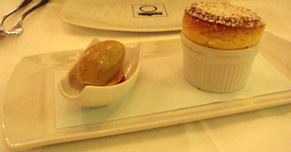
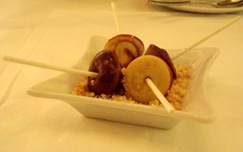
We usually skip dessert, but had to try a Sweet Potato–Almond Soufflé, which was excellent. The petits-fours were a bit underwhelming, but by then it hardly mattered. Throughout the evening, service was practically perfect, as a restaurant this expensive should be.
The wine list is heavily French, with good selections at all price ranges. Eric Asimov’s wine column last week was about the Jura, a region seldom featured on New York wine lists. Sure enough, Oceana had one, at $57, the Jacques Puffeney “Cuvée Sacha, 2001. The sommelier accurately described its nutty flavor, so we ordered it and were not disappointed.
We are not quite sure why, but the wine and two cocktails were comped. We never introduce ourselves as food bloggers, and though the staff surely noticed our camera, lots of people take photos without posting a review—not that this blog is that influential anyway. Anyhow, it was rather dull-witted of us not to notice this until the next morning, as we would have left a much larger tip.
We point this out in the interest of full disclosure, but we are quite sure that our conclusion would have been the same. We were sold on Oceana.
Oceana (1221 Sixth Avenue at 49th Street, McGraw-Hill Building, West Midtown)
Food: ***
Service: ***
Ambiance: ***
Overall: ***









